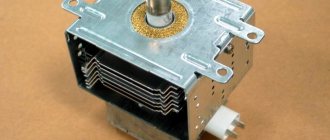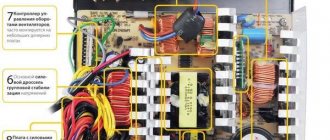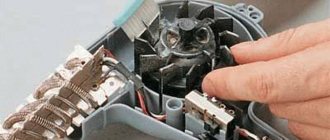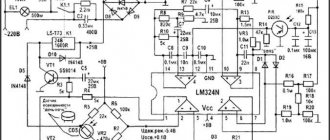The design and principle of operation of a CRT TV
Many fans of retro technology are interested in the question of what a CRT TV consists of. The design is simple: a glass flask, at one end of which a cathode ray tube is attached, and at the other end there is a screen itself, which is coated with a special phosphorus-containing composition.
A stream of electrons, also called an electron beam, will be emitted from the tube. The beam is directed at the phosphor pixels, after which the glow begins.
CRT TVs came in two varieties: black and white and color.
The black and white models had only one beam tube installed, while the color varieties had three to transmit blue, red and green colors.
The electron beam is directed from the left to the right side, creating a pixel line, and then moves downward, creating a new line. Because the beam moves very quickly, the human eye cannot perceive the entire image.
Liquid crystal (LCD) televisions
Years of research, development and improvement of sophisticated liquid crystal technology have led to a real revolution in the field of television production. Stylish flat panels appeared on the market, which began to differ from their predecessors both in appearance and many times superior to them in all respects. The elimination of the need to use a bulky kinescope made it possible to produce models of various shapes and designs - to suit every taste.
The new product quickly gained universal popularity.
Advantages
- high-quality clear image;
- light weight;
- increased scan frequency – no flicker;
- acceptable viewing angle;
- absence of electromagnetic radiation.
Flaws
- poor black color saturation creates glare when viewed in brightly lit rooms;
- Long response times may cause blur.
Advantages and disadvantages
The main advantages or what is valuable in a kinescope:
- Wide variety of models.
- Low price for products.
- Reliable technologies and circuitry.
- Natural color rendition and good image quality.
- Service life is more than 15 years
Minuses:
- CRT TVs are not repaired everywhere. Modern masters specialize more in LCD TVs. Therefore, there are few places where CRT TV malfunctions can be eliminated. It is worth noting that malfunctions can occur more often than on LCD screens. For example, if Samsung, Rolson or Erisson does not turn on, then it will be extremely difficult to look for a repairman. Common breakdowns: the monitor does not light up, but there is sound, the indicator lights up, but the screen does not turn on, the relay clicks when the device is turned on, a wide band appears on the kinescope screen due to problems with frame scanning.
- Screen size is small. If a person watched films on a large modern TV, he will be uncomfortable with the kinescope version.
- The device is heavy and has impressive dimensions. Modern television devices are flat and weigh less compared to heavy old models.
- Problems with connecting to digital broadcasting. You will need to buy special consoles and configure them.
- A CRT TV cannot be hung on the wall because it will take up a lot of space.
- The screen may begin to “shower” with dots. In this case, you will need to replace the kinescope in the TV. If you can’t find a workshop, you’ll have to dismantle it yourself. There are also difficulties in purchasing the kinescope itself.
- Difficulties with disposal due to large dimensions.
A retro fan's sobs over an old TV
Oh that's it. I have always wondered where a retro hobby is... not the bottom, but the border of a serious hobby, on the verge of insanity. Now I know it's an old CRT TV. They are heavy. They flicker. The image quality is tolerable at best, or so it seemed to me at first. When you buy a buzzing box with thousands of volts inside, you've taken your collecting to the next level and there's no turning back. Seriously, warm (naturally, they get hot) tube (at least one) TVs are a big stage in the development of technologies, both home television and computer. A stage that ended with a rather abrupt transition to skinny LCD screens within literally five years, at the end of the 2000s. Although many of us (or relatives) still have an old TV in their dachas or even at home, it won’t last long. They don't make them anymore, it's too difficult and not worth it. They have a shorter lifespan than LCD displays. We are seeing the end of the life cycle of a wide range of technologies, and the consumer habits associated with them are becoming a thing of the past.
These are the features of old television, watching video from analogue sources on a blue screen, and eight-bit gaming that I want to remember today.
Well, look for examples of tasks in which CRTs are still unrivaled. I’ll start with the simplest argument about the advantage of a TV with a tube: it’s stylish! Look how luxurious the box is! What an outrageously non-flat screen! What divine twists! It's like a microwave (with a toaster), but instead of food, it fuels nostalgic feelings. I keep a diary of a collector of old pieces of iron in Telegram.
Near-technical introductory
I will not describe in detail the technology of operation of CRT TVs - otherwise you may get the feeling that I understand them, but this is not the case. Basic things can be found anywhere, from Wikipedia to YouTube. I will try to formulate those points that are important for the rediscovery of this retro technology. Well, for example: “The invention of the television was preceded by the discovery of cathode rays - a flow of electrons accelerated in a vacuum by the potential difference between the cathode and anode.” The following is important here: for this circuit to work properly, shooting electrons must be done in a vacuum. It is the pumping of air out of the picture tube that makes thick glass walls necessary to withstand atmospheric pressure, which is why all CRT televisions are heavy. And one more thing: a voltage of thousands of volts is supplied to the kinescope, which can be fatal if handled carelessly.
Next: the hot cathode, the source of cathode rays, is heated to a temperature of hundreds of degrees. Tube TVs get hot and consume relatively a lot of electricity. A stream of electrons strikes the phosphor, causing a glow. Without the electromagnet system, we would end up with one bright point in the center of the screen, but with their help, the flow of electrons can be deflected. Every second, a TV (PAL or SECAM) uses cathode rays and electromagnets to pass across the entire screen 50 times, from top to bottom and from left to right. For each of the 50 passes, only half the frame is displayed, each even or odd line. There are 25 full frames of 625 lines each (visible - 576), which is enough to create the illusion of moving pictures. If you photograph the screen with a fast enough shutter speed, you can see the image creation process in action:
Conclusions: The frame refresh rate of 50 hertz feels different from the same on an LCD TV, where the entire frame is displayed at once. Oh yes, our TV is color, and this makes the whole scheme even more complicated. Instead of one, there are three electron guns; they are responsible for the red, green and blue components of the image, respectively. A shadow mask appears in front of the phosphor layer: an iron mesh with microholes, thanks to which the flow of electrons from the “red” emitter hits only the “red” phosphor. Let's display a solid white fill on TV and take a photo with a macro lens:
I just want to write: red, green and blue pixels “burn” at the same time, making it seem to us that we see white. These aren't actually pixels: just areas on the screen that light up when exposed to a flow of electrons. In a CRT TV there is no way to light up one pixel at an arbitrary point on the screen: such technology simply does not operate with such concepts. You can look at the boundary between the white and black areas: due to the analog nature of the CRT, it is not as clear as on a modern display.
Finally: the phosphor does not last forever, it burns out. Degradation also occurs with LCD displays: the crystals may become “stuck” in the open or closed position, and the backlight may go dark. But in a CRT this happens differently: a TV that is constantly on gradually loses the brightness and contrast of the image and becomes faded. If you display static elements on it (TV channel logo, Start menu), this particular part of the phosphor may burn out, and then the logo will remain with you forever. A good TV can work 8 hours a day for many years in a row. A screen that is not turned off for days will dry out in 5-7 years. While there is no problem finding a CRT TV in good condition, but even with careful use it will sooner or later fail. However, it will be enough for my lifetime.
Personal TV story
To properly tune in to the wave of memory, I will attach a photo of the TV of my childhood - model Horizon-736. It survived until the late nineties, first as the main screen for family viewing, then as a monitor for an eight-bit computer. Although broadcasting itself is not my area of interest, it is indispensable: from pre-war times until the late seventies (and in my case, the early nineties) it was the only way to display something on your TV screen. Full-fledged television broadcasting began after the war, and my grandmother still remembered a typical television receiver of those years, “with a lens”:
This is a KVN-49, and you can immediately see that it differs from the “Horizon” in the screen diagonal: 18 centimeters versus 61, or in later established inches - 7 versus 23. In addition to the screen size, image parameters improved over time - brightness and contrast, and the lifespan increased kinescope, from hundreds of hours to tens of thousands in the best copies.
Although modern LCD matrices contain much more technology, it seems that making a kinescope is more difficult. It was certainly a unique production, which could not be simply resumed (in the unlikely event of a CRT renaissance). This video shows some stages of picture tube production: Everything is Very Complicated. In the nineties, a video recorder was added to the television broadcast, as well as an eight-bit computer - first a version of Radio86-RK, and later a clone of the ZX Spectrum. The tired Horizon was replaced with an imported 21-inch JVC. Foreign technology was a breakthrough in terms of brightness and richness of the picture, although there was some loss in screen size. In addition, a full-fledged linear input was added, and before that it was necessary to use RF modulators, with an inevitable loss in quality. To hell with the quality, the main thing is the remote control, the remote control has appeared! No longer did you have to get up from the couch to change the channel! The old TV eventually moved to the garage - it was a shame to just throw it away. I will never forget this feeling of completeness and instability when you go down the stairs with a Soviet TV in your hands.
My parents and many friends had standard, inexpensive imported TVs with a diagonal of 21 inches that lasted 10-15-20 years and were replaced with large LCD screens. Our copy is still alive, shows movies in the country, although it can no longer receive terrestrial TV on its own - it requires a decoder for a digital signal. With the shutdown of analog TV, a big story ended: when a signal was transmitted through the air that directly controlled all the electronics of the TV with a tube. In addition to the properties of the receiver, the ancient television experience was influenced by the favorable location of the house relative to the television tower, the quality of the antenna, well (or poorly) wired connectors, the presence of a radio amateur in a neighboring house or a sparking vacuum cleaner on the floor above. It was as if we were watching not a series or news, but the entire world around us, with stripes, snow and ripples.
TV sets are often not replaced, and I missed the CRT progress of recent years, already at the beginning of the twenty-first century. Meanwhile, technology developed to the very end. In the late nineties, widescreen CRT televisions appeared. The screen sizes increased, reaching a maximum of 40 inches. However, in real life you are unlikely to find an old TV with a diagonal larger than 36″, and the most common sizes are 28-32. These were monstrous devices weighing under 50 kilos. In them, the gold standard was doubling the frame rate to 100 hertz, which eliminated flicker. The latest TVs have an HDMI connector and process digital images with a resolution of up to 1080i (by the way, they are not recommended for retro due to lags). Around 2007, there was a sharp drop in sales of heavy televisions: consumers voted for compactness, high resolution LCD displays and other conveniences of the new era. Large vendors stopped showing new models at exhibitions one year - the CRT was definitely considered obsolete. CRT manufacturers went bankrupt. Now CRT TVs are inferior to modern flat TVs in almost everything: from resolution to diagonal, brightness and contrast. It turns into retro, but this is for the most connoisseurs with good physical fitness or a couple of friends. High-quality CRT computer monitors are now very expensive, but you can simply get a TV for free or for pennies, just pick it up.
Give me back my 1986
I didn’t choose this TV based on any clear criteria, it happened by chance. I was attracted by the unusual appearance - some kind of microwave oven - and the relatively small dimensions. This is a Panasonic AG-500, and in fact it would be correct to call it a professional video monitor. But not in the sense of “used in the television and film industry.” Relatively portable (26 centimeters or ~10 inches of screen), with a built-in video player, it was designed for business. For example, for installation in public places. A special feature of the built-in video recorder is the ability to play the tape in a circle: turn on a commercial for your dental office and torment visitors with it until they are ready. I imagine that such a thing could be installed on a bus, used to quickly screen tapes from the library, make a portable video system at school, and the like. In addition to the design, I was attracted by this self-sufficiency, as well as the presence of a video input. The fact that the TV does not actually have a TV channel receiver did not upset me at all - there was nothing to catch there anyway.
Judging by the date in the service manual, the model was developed in the mid-eighties. In the early nineties, it was sold in the United States for $500 - a lot of money for a compact model.
A TV at this age may suffer from a large number of ailments, have a shriveled kinescope or burnt-out sectors from static elements of the video surveillance system. I was lucky, although I bought it without checking: the only fault was a cassette stuck inside, which over time became so warped that I had to disassemble the entire mechanism. I pulled it out, manually turned the loading and unloading mechanism to the normal position, and everything worked. Marvelous! The advantage of professional equipment: it was made so that it works even in the most difficult conditions. Even the two rubber drives in the cassette mechanism did not melt over time, which is absolutely fantastic. Okay, I put in the Terminator cassette and have an amazing flashback on the side table. He looks like a visitor from the past, and works the same! The picture is of high quality, but the cassette mechanism itself is basic, with two heads and without any means of enhancing the image from VHS. The sound is monophonic, no Hi-Fi stereo, but this is even better. Videotape artifacts and a slightly droning soundtrack are quite appropriate here. This is exactly how we watched movies back then, except the screen was bigger.
Hidden under the folding panel are standard brightness and contrast controls, and a Vertical Hold knob, which allows you to correct the synchronization of the video signal if something goes wrong. In our case, it’s more likely to disrupt the synchronization in order to create authentic artifacts of the old TV image: The tracking on the videotape is also manually adjusted, separately for playback and pause modes. Frame-by-frame viewing is another interesting feature of the tape recorder. Again, by twisting the handle, we evoke from oblivion the effect of a chewed cassette from a video store: Here it is, our happy analog childhood! Is it possible to compare an image using 80s technology with a modern screen? The retro tablet Apple iPad 2 is suitable for this: the screen sizes are similar, the same aspect ratio.
It is clear who will win in terms of resolution, although the brightness and color rendition of CRTs are not bad. The main thing is that in 2022 you want to have a device with all the artifacts from the past. Turning on high-voltage circuits with a whistle, gradually increasing image brightness as it warms up. Even the lack of a remote control doesn’t interfere - if you want to pause it, come and put it on! The most annoying thing is that same flickering with a frequency of 50 hertz: we are completely unaccustomed to it. Although if you watch old TV for at least an hour, you stop noticing.
Old content
A great companion for an old TV is a DVD recorder, they are also selling very cheaply now. First of all, I noted how much better the quality of the picture from DVD is compared to the built-in VHS. But it's not just about DVD: the recorder is capable of converting any type of analog signal into the composite signal required for this TV. For example, you can connect my Pentium 4-based retro computer via S-Video:
But these are half measures. I connect a Raspberry Pi 3 microcomputer to my TV. All versions of the Pi have a composite video output that can work with older TVs. Installing Kodi media player. I get a retro TV with the ability to stream from YouTube, controlled from a smartphone. But here ancient, era-appropriate content would be more appropriate:
The personal time machine has been completed, but the most interesting things are yet to come.
Unbridled retrogaming on an emulator
In a good way, if you have an authentic TV, you should not stop and buy an original game console or an eight-bit computer. The assortment here is huge, and I don’t even know where to start yet - either with Spectrum, or with “Dandy”. Emulation on Raspberry Pi is a decent way to try it first to see if you like it. I use the RetroPie distribution tailored for retro games (more precisely, a fork of CRTPi optimized for composite) and connect a Logitech F710 wireless joystick.
This is where I had to step back and study a phenomenon known as 240p. Those same consoles from the 80s and 90s (up to the sixth generation of game consoles at the turn of the century) instead of 480 interlaced TV lines display the picture differently: 240 progressive lines, that is, they skip every second line. In fact, there may be fewer working lines in the image of different set-top boxes in different regions (192 or 224, for example), it is the principle of their display that is important. Any analog video transmission standards support 240p without problems. Problems begin when you try to connect the old console to a new TV, which essentially digitizes the analog signal. Often he tries to convert 240p to 480i, and spoils the picture, loses lines, and some special effects break completely.
The 480i or 576i mode is quite suitable for cinema, but for a computer image it is not ideal: on contrasting horizontal lines, of which there are many in such an image, there is blurriness and flickering, as can be seen in the photo above - the RetroPie interface is output in 480i. It is not easy to read Kodi menu items, especially small ones.
But in the emulator with the correct settings on the CRT there is a beautiful, clear image. For real consoles and for emulators, there is modern software 240p Test Suite, which allows you to make sure that you really have the “correct” mode. You can also evaluate the geometry of the screen:
And on my TV, everything is surprisingly good, which is generally not guaranteed. Good - not in the sense of ideal, but “it can be much worse.” There is noticeably poor beam convergence in the top right corner, which I can live with. The most important thing: games for old consoles were developed for old TVs, taking into account their features. They look more “correct” on a CRT than in an emulator on a modern display. Look:
The relative blurriness of the image, the lack of rays hitting specific points on the screen, and distortion of the composite video signal give the bricks in Super Mario additional texture and volume. The image appears soapy in the photograph, but in reality everything is fine. Another example from the NES Metroid game:
Retro picture of a healthy person. How does this interfere with playing old games on an emulator at 4K resolution? Doesn't interfere at all. But with the help of my old TV, I can now play Super Mario Bros authentically
.
Do I want to recommend everyone to buy old TVs before it's too late to take out unnecessary heavy boxes from the closet? Not necessarily, although if you have an old TV in your country house, a small investment in a microcomputer with a composite output will give it a second life. Moreover, my particular TV was purchased mainly for its stylish appearance and compact size. At 20-27 inches of a large CRT it can turn out even better. There are many ways to realize the ideal “analog” image. By modding the Raspberry Pi to output a higher-quality component RGB signal, or by connecting to a computer CRT monitor via VGA with obviously better characteristics. Either by modifying older consoles or using the native component output on later consoles (Playstation 2/3 or Xbox 360S). Even a TV without an RGB input can be modified - anyway, the signal inside is decomposed into red, green and blue components, why not feed it a better quality image? There are many steps down this rabbit hole. Someday I will definitely do this improvement, but not on this TV, it is good as is, without modifications. Or bad, it depends on your starting point.
Such a renaissance of CRT in a single apartment. You can't bring back your childhood - I realized this when I played Super Mario Bros on a Nintendo emulator. I passed solely thanks to the ability to save at any time, and at the last levels - also with the help of tips on the Internet. To hone the honest skill of jumping on bricks - I no longer have enough time or nerves for this. But as you get older, you often get the feeling that your school years are not about you at all, but about some other person. Every time I turn on my tube TV, it makes me feel “like it was then” and restores the conventional connection between the past and the present. I'm glad that I now have a choice - when I do my adult things, solve (or put aside) adult problems, I can take my mind off it all in a modern AAA release in 4K resolution. Or I can do it like this - in the atmosphere of fuzzy, but for me no less beautiful eight-bit graphics of bygone times. With complete immersion in the past, right down to the interference from the video signal penetrating into the sound.
Connectors in CRT TVs
On CRT TVs, only analog types of connectors were installed. Modern LCD equipment is additionally equipped with digital inputs.
Analog connectors:
- RF input. The connector is used to connect an antenna, satellite boxes or DVD to the TV. The signal reception quality is not the highest.
- A/V input. Such equipment is often called tulips. Typically, manufacturers install special color codes on the ports - yellow, white and red. Audio and video signals are transmitted separately on each cable.
- S-Video. This option is quite often used in modern conditions, since it is convenient to connect various DVD devices and game consoles through such ports.
- SCART. This is a long and flat port with 21 pins. Through this output you can transmit video and sound and even digital TV channels.
LED TVs
Essentially, these are the same liquid crystal panels with the same characteristics and with only a few differences. They are due to the design features - the screen is backlit not using lamps, but using an LED matrix.
- The main difference is better black color saturation, which makes the image look more attractive.
- LED lighting is more reliable. If it breaks, it is easier to replace than lamps.
- Electricity consumption is almost one and a half times lower than standard LCD TVs of the same size.
Today, this type of TV is the most common all over the world.
How will TV develop further?
TVs have a great future. They are already starting to become more “smart” every year. Over time, televisions will be able to turn into dedicated media centers. Voice input appears and will continue to develop in devices. More and more people will begin to switch from program guides to video on demand. It is assumed that premium TVs will come with devices that will be synchronized with them. The remote control will become a thing of the past, and other gadgets may replace it. Even now, TVs come with special docking stations, with which the TV and monitor can be used as a computer. In addition, smart home theaters are expected to emerge. High-definition video projectors will be supplied for them. Soon the picture quality problem can be solved. One of the innovations for TVs can be considered the introduction of neural networks, which will provide the user with even more opportunities.











